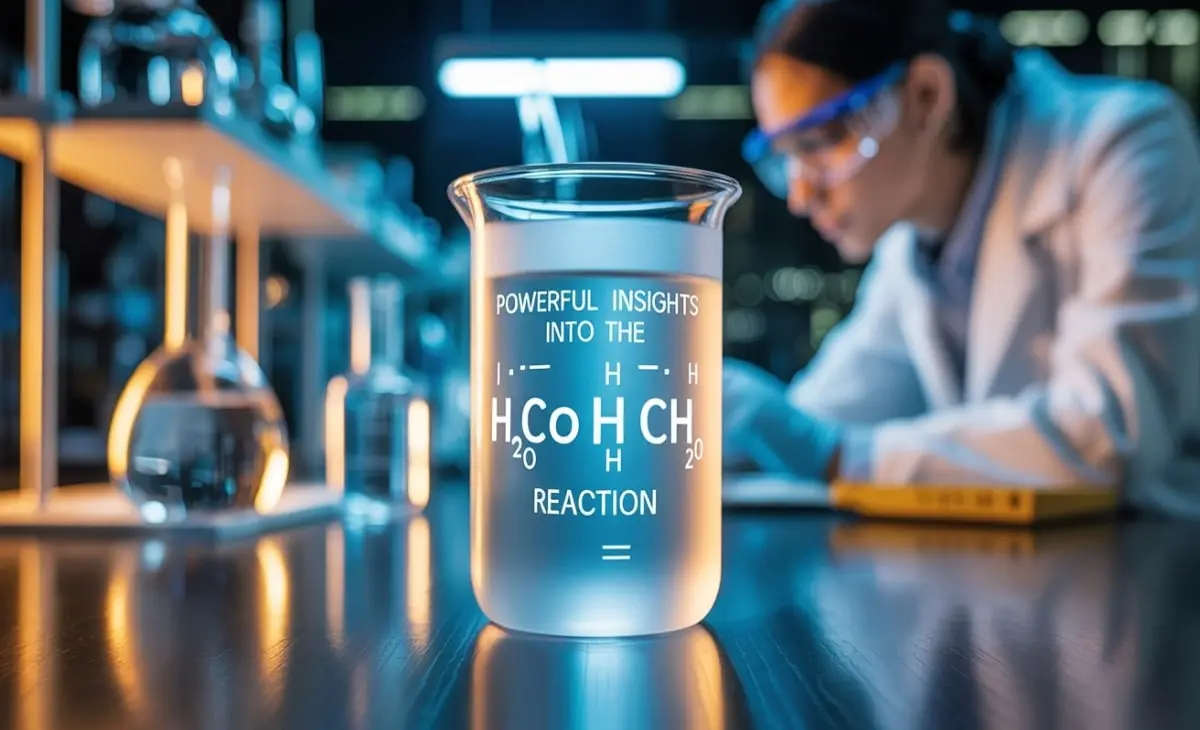Knowing how to read molecules is at the heart of modern chemistry. One such intriguing reaction involves HCOOH (formic acid), CH₂ (methylene group), and H₂O (water). If you’re searching for hcooch ch2 h2o, you’re likely looking to uncover how these molecules interact, what kind of reaction takes place, and what role this chemistry plays in real-world applications. Whether you’re a chemistry student, a researcher, or just an enthusiast, this breakdown is crafted to help you fully grasp the essence and importance of this reaction.
What is the hcooch ch2 h2o reaction?
The term hcoochch2 (CH₂H₂O) combines three essential molecular species: formic acid (HCOOH), methylene (CH₂), and water (H₂O). In organic chemistry, these compounds often interact during hydration or oxidation reactions. The central focus often revolves around either nucleophilic substitution or hydrolysis mechanisms involving esters or carboxylic acids.
The reaction typically represents a transformation where formic acid and a methylene compound in the presence of water produce formate derivatives or intermediate alcohols. This might appear during biochemical processes, industrial synthesis, or academic chemical experiments.
Explore more insights on our homepage for the latest updates.
Chemical Nature of Each Component in Hooch (CH₂ H₂O)
Formic acid (HCOOH) is the simplest carboxylic acid, naturally occurring in ant venom. It’s a colorless liquid with a pungent smell and is used in leather production, as a preservative, and in dyeing textiles.
Methylene Group (CH₂) represents a highly reactive group, often bonded to other carbon chains or functional groups. Its presence in organic molecules makes it a common reactive intermediate in numerous organic reactions.
Water (H₂O) acts as a universal solvent and, in this context, often facilitates hydrolysis or participates as a reactant in oxidation or reduction pathways.
How the Reaction Occurs in Practice
The most typical scenario where hcooch ch2 h2o come together is during formylation reactions or in the hydrolysis of methyl esters. For instance, a reaction involving formic acid and methylene derivatives under aqueous conditions can yield formate esters or hydroxymethylated compounds depending on the catalyst and temperature.
In laboratory settings, this reaction may also simulate atmospheric chemistry processes or degradation pathways of larger organic molecules, especially during combustion or photolytic reactions.
The importance of the HCOOCH₂H₂O Reaction in Organic Chemistry
This reaction holds educational and industrial value. In organic synthesis, it demonstrates how functional groups interact in aqueous media. For students, it serves as a foundational experiment to study acid-base interactions, reaction kinetics, and mechanistic pathways.
In industry, such reactions help synthesize pharmaceutical intermediates, agrochemicals, and even biofuel precursors. Their simplicity allows them to be scalable and cost-effective.
Molecular Mechanism of the HCOOCH₂H₂O Reaction
The mechanism begins with protonation or activation of the carbonyl group in formic acid. When methylene or its equivalent interacts, a nucleophilic attack may occur, depending on the electron configuration. Water either stabilizes the transition state or participates directly in the breakdown of intermediates, resulting in an alcohol or an acid derivative.
Reaction conditions such as pH, temperature, and solvent polarity significantly affect the pathway and yield.
Thermodynamics and Kinetics Behind the hooch: the CH₂ + H₂O reaction
Understanding the energy profile of the hcooch ch2 h2o reaction is essential for predicting reaction outcomes. It is typically an exothermic process, releasing energy due to bond formation. The activation energy is low in the presence of a catalyst, which accelerates the reaction rate significantly.
The rate-determining step often involves the formation or cleavage of a carbon-oxygen bond, moderated by the acidity of the formic acid and the nucleophilicity of the methylene group.
Common Laboratory Applications
This reaction is frequently used in organic synthesis labs to teach concepts of reaction mechanisms, proton transfer, and nucleophilic substitution. It helps students visualize molecular transformation in real time.
In analytical chemistry, it aids in identifying functional groups and confirming structural changes through IR spectroscopy, NMR, or mass spectrometry.
Environmental and Industrial Relevance
Industrially, formic acid and water are common in processes like paper bleaching, leather tanning, and rubber coagulation. Reactions involving methylene can be vital in producing polymers or plasticizers.
Environmentally, these reactions mimic atmospheric transformations of pollutants and natural organic matter. Understanding their chemistry helps in modeling acid rain effects, soil chemistry, and aquatic biogeochemistry.
Challenges in Handling the HCOOCH₂H₂O Reaction
Despite its usefulness, this reaction isn’t without complications. The volatile nature of formic acid, the reactivity of methylene, and the complexity of water’s behavior as a solvent or reactant add unpredictability.
Maintaining the correct stoichiometric ratio and temperature control is crucial to avoid unwanted side reactions or low yields. Furthermore, product separation can sometimes be difficult due to the polarity of resulting compounds.
How to Set Up the HOOCH CH₂ H₂O Reaction Step-by-Step
Setting up this reaction in a lab requires precision and care. First, measure stoichiometric amounts of formic acid and methylene precursor (such as diazomethane or formaldehyde). Dissolve them in a water-rich environment or an aqueous organic solvent.
Stir the mixture under controlled temperature, usually under 50°C. Monitor the pH and maintain mild acidity to promote proper interaction. Use a reflux setup if volatile reactants are involved. After sufficient reaction time, quench the system and extract the product using chromatography or distillation.
Real-World Examples and Case Studies
In pharmaceutical synthesis, methylene-bridged formates derived from this reaction are intermediate compounds for analgesics and anti-inflammatory drugs. One case study involves the synthesis of a precursor to ibuprofen, which uses similar steps involving formic acid and methylene derivatives.
In agriculture, certain pesticides and herbicides rely on reactions akin to hcooch ch2 h2o for stability or breakdown in soil and water environments.
Theoretical Insights from Computational Chemistry
Molecular modeling studies confirm that the transition states in HCOOCH₂H₂O reactions involve charge delocalization, which is stabilized by the polarity of water. Quantum chemistry methods such as DFT (Density Functional Theory) facilitate the visualization of electron movement, thereby enhancing our understanding of the reasons behind the preference for certain products over others.
Safety Considerations When Performing the Reaction
Formic acid is corrosive, and methylene derivatives can be toxic. Always conduct reactions in a fume hood wearing appropriate PPE (Personal Protective Equipment). Water doesn’t pose direct hazards but must be managed to prevent spills or pressure buildup.
Waste must be neutralized and disposed of according to local chemical waste disposal regulations.
Role of Catalysts in Enhancing the Reaction
Acidic or basic catalysts dramatically improve the efficiency of this reaction. For instance, sulfuric acid as a catalyst increases the rate by protonating formic acid, making it more electrophilic. Alternatively, base catalysts like NaOH facilitate nucleophilic attack by activating the methylene compound.
Catalysis not only improves yield but also guides selectivity toward the desired product.
Sustainability and Green Chemistry Angle
Using water as a solvent aligns with green chemistry principles. Sustainable synthesis favors reactions that utilize less hazardous reagents, such as formic acid over stronger acids. Researchers are also investigating biocatalysis, which involves using enzymes to mediate similar transformations under ambient conditions.
Modern Techniques for Monitoring the Reaction
Advancements in real-time spectroscopy, like in-situ FTIR and UV-Vis, allow chemists to track the HOOCH CH₂ H₂O reaction dynamically. Coupled with automated titration and chromatography, labs can now optimize parameters on the fly.
Future Trends and Innovations
Scientists are developing microreactor systems to conduct such reactions in flow setups, enabling precise temperature and concentration control. AI-assisted reaction prediction tools are also gaining popularity, as they have the potential to model the behavior of HOOCH CHH O under various conditions, eliminating the need for trial and error.
Common Misconceptions About the Reaction
Many believe water only acts as a solvent in this reaction. However, it plays a much more active role, often participating in the hydrolysis or formation of hydrogen bonds that stabilize intermediates.
Others think the reaction only works under extreme conditions, whereas mild lab settings can produce excellent yields with proper technique.
HCOOCH, CH2, and H2O Reactions in Academic Curricula
University-level organic chemistry courses often introduce this reaction as a gateway to understanding carbonyl chemistry, hydration reactions, and nucleophilic substitution. Lab manuals may use a variation to teach titration, solvent extraction, or pH control.
Frequently Asked Questions
What kind of reaction is HCOOCH₂H₂O?
This is primarily a nucleophilic substitution or hydrolysis reaction involving a carboxylic acid, methylene group, and water.
Can HOOCH CH₂ H₂O produce esters?
Yes, under specific conditions, it can yield formate esters or hydroxymethyl derivatives depending on the reactants and catalysts used.
Is this reaction reversible?
It can be reversible, especially in the presence of water and under neutral pH conditions, as ester hydrolysis is often reversible.
What safety precautions should I follow?
Use gloves and goggles, and conduct the experiment in a well-ventilated space. Formic acid is corrosive, and methylene compounds can be volatile.
How does water influence the reaction?
Water acts both as a solvent and a reactant, influencing the reaction rate, stabilization of intermediates, and product formation.
Where is this reaction used in real life?
It is used in pharmaceutical synthesis, environmental chemistry, and academic research involving carboxylic acid derivatives.
Final Thoughts
Understanding the hcooch ch2 h2o reaction unlocks a deeper appreciation for the subtleties of organic chemistry. From academic labs to industrial applications, this reaction showcases how small molecules can drive big innovations. With proper safety, clear objectives, and a grasp of the underlying principles, anyone can harness this reaction for insightful discoveries.
Explore more advanced reactions or replicate this process in your lab environment to truly experience the wonders of chemistry firsthand.
Are you prepared to delve deeper into chemical mechanisms or require assistance in setting up a lab version of this reaction? Start your journey today with trusted academic resources or reach out to a chemistry mentor.





